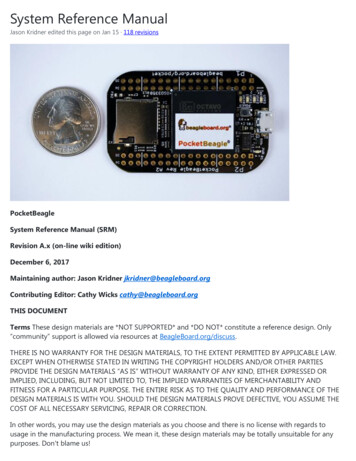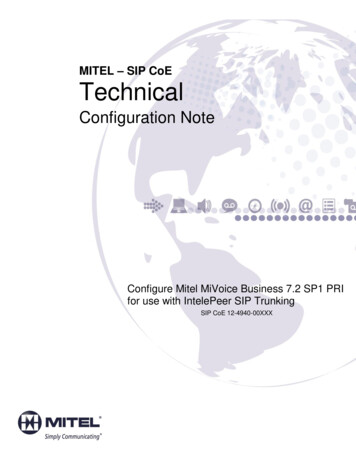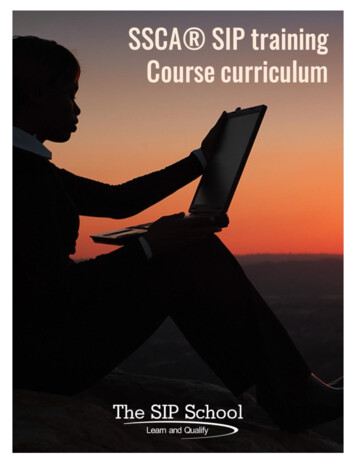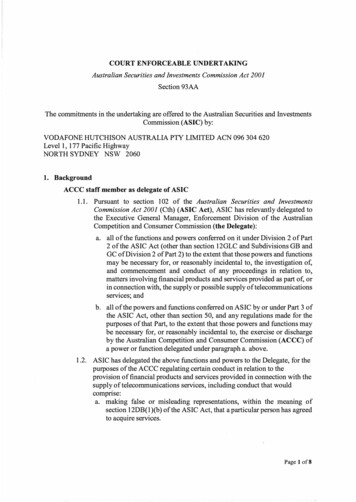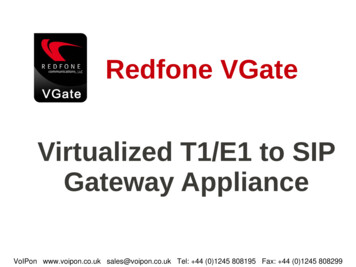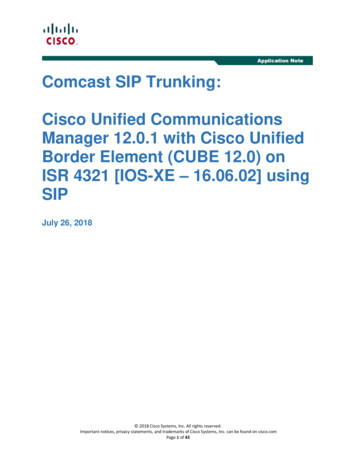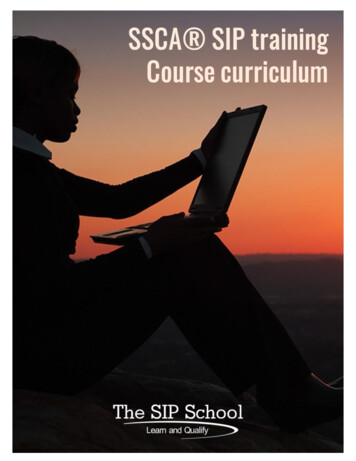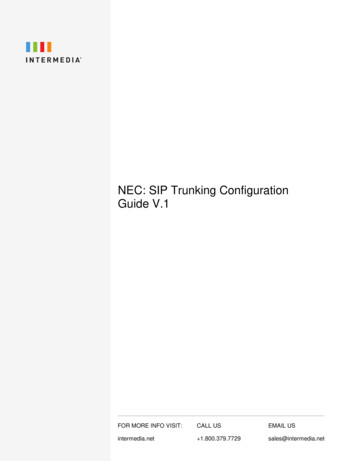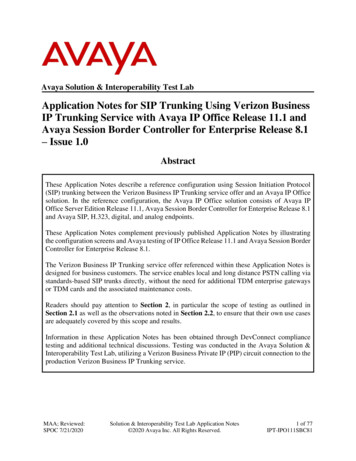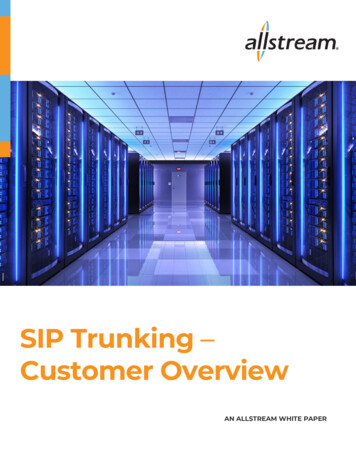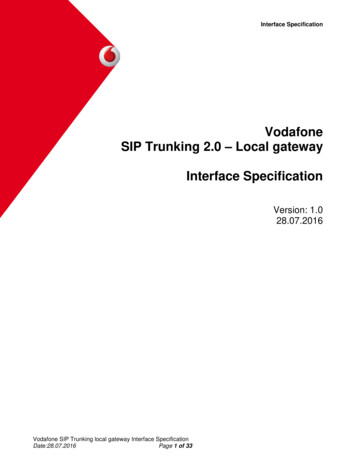
Transcription
Interface SpecificationVodafoneSIP Trunking 2.0 – Local gatewayInterface SpecificationVersion: 1.028.07.2016Vodafone SIP Trunking local gateway Interface SpecificationDate:28.07.2016Page 1 of 33
Interface SpecificationContentsContents .2Conventions .3Contact.41Scope .52References .62.12.22.33Normative References .6Informative References .6Reference Acquisition .6Definitions and Abbreviations .83.13.2Definitions .8Abbreviations .94General overview. 115Support . 125.15.25.35.46Supported standards . 12Supported protocol stack . 12Supported codecs . 12Supported end user feature list . 12Adressing/Routing and formats . 166.16.26.37NAT traversal . 16SBC detection . 17Addressing formats . 18‘Regulatory requirements, e.g. emergency call . 227.17.28Emergency calls . 22Special Numbers . 22Special arrangements on SIP methods . 238.19IMS Registration . 23Timer configuration . 231010.110.210.31111.1Capabilities . 23Basic call scenario description for originating and terminating voice calls . 23FAX Calls . 26DTMF . 32Security requirements . 32Encryption . 32History . 33Vodafone SIP Trunking local gateway Interface SpecificationDate: 28.07.2016Page 2 of 33
Interface SpecificationConventionsThe key words "MUST", "MUST NOT", "REQUIRED", "SHALL", "SHALL NOT", "SHOULD", "SHOULDNOT", "RECOMMENDED", "NOT RECOMMENDED", "MAY", and "OPTIONAL" in this document are to beinterpreted as described in IETF RFC 2119.Vodafone SIP Trunking local gateway Interface SpecificationDate: 28.07.2016Page 3 of 33
Interface SpecificationContactVodafone GmbHFerdinand-Braun-Platz 140549 DüsseldorfGermanyTelefon: 49 (0)800 172 1212Website: www.vodafone.deVodafone SIP Trunking local gateway Interface SpecificationDate: 28.07.2016Page 4 of 33
Interface Specification1 ScopeIn the context of Vodafone SIP Trunking 2.0 project a local gateway also known as Integrated AccessDevice (IAD) shall be introduced to offer classical ISDN BRA/PRA access towards end-user whileconnecting to an IMS core including application server on the network side.This document describes the basic functionality and the service specific functionality required from thelocal gateway to support Vodafone’s SIP Trunking service.This interface specification may be changed at any time. The user of this interface specification has tocheck for the newest version available from Vodafone GmbH. This interface specification may besuperseded in total or in part by the terms of a contract between the individual network user and VodafoneGmbH.Vodafone SIP Trunking local gateway Interface SpecificationDate: 28.07.2016Page 5 of 33
Interface Specification2 ReferencesIn the case of a conflict between specific requirements in this document with requirements in any of thedirectly or indirectly referenced documents, the specific requirements of this document are applicable.2.1Normative References3GPP TS 24.2293GPP TS 24.407 Rel.73GPP TS 24.504 Rel.83GPP TS 24.508 Rel.8RFC 791RFC 2617RFC 2833RFC 3261RFC 3262RFC 3263RFC 3264RFC 3311RFC 3323RFC 3325RFC 3398RFC 3455RFC 3550RFC 3551RFC 4028RFC 4040RFC 4566SIPConnect 1.12.2IP multimedia call control protocol based on Session Initiation Protocol (SIP)and Session Description Protocol (SDP); Stage 3PSTN/ISDN simulation services; Originating Identification Presentation(OIP) and Originating Identification Restriction (OIR)PSTN/ISDN simulation services ; Communication diversion (CDIV)PSTN/ISDN simulation services; Terminating Identification Presentation(TIP) and Terminating Identification Restriction (TIR)Internet ProtocolHTTP Authentication: Basic and Digest Access AuthenticationRTP Payload for DTMF Digits, Telephony Tones and Telephony SignalsSIP: Session Initiation ProtocolReliability of Provisional Responses in the Session Initiation Protocol (SIP)Session Initiation Protocol (SIP): Locating SIP ServersAn Offer/Answer Model with the Session Description Protocol (SDP)The Session Initiation Protocol (SIP) UPDATE MethodA Privacy Mechanism for the Session Initiation Protocol (SIP)Private Extensions to the Session Initiation Protocol (SIP) for AssertedIdentity within Trusted NetworksIntegrated Services Digital Network (ISDN) User Part (ISUP) to SessionInitiation Protocol (SIP) MappingPrivate Header (P-Header) Extensions to SIP for 3GPPRTP: A Transport Protocol for Real-Time ApplicationsRTP Profile for Audio and Video Conferences with Minimal ControlSession Timers in the Session Initiation Protocol (SIP)RTP Payload Format for a 64 kbit/s Transparent CallSDP: Session Description ProtocolTechnical RecommendationInformative ReferencesSIP Trunking Empfehlung2011Bitkom Position Paper "SIP Trunking - Detailempfehlungen zurharmonisierten Implementierung in Deutschland“, 2011.3GPP ETSI TS 29.163Interworking between the IP Multimedia (IM) Core Network (CN) subsystemand Circuit Switched (CS) networks (Release 8) or at least ITU-T Q.1912.5 Interworking between Session Initiation Protocol (SIP) and BearerIndependent Call Control Protocol or ISDN User PartInternet Protocol, Version 6 (IPv6)RFC 24602.3Reference Acquisition 3GPP: http://www.3gpp.org bitkom: /Business-Communications.html European Telecommunications Standards Institute: http://www.etsi.orgVodafone SIP Trunking local gateway Interface SpecificationDate: 28.07.2016Page 6 of 33
Interface Specification Internet Engineering Task Force (IETF) RFCs: http://www.ietf.org SIP Forum: http://www.sipforum.org/sipconnectVodafone SIP Trunking local gateway Interface SpecificationDate: 28.07.2016Page 7 of 33
Interface Specification3 Definitions and Abbreviations3.1DefinitionsThe definitions in the referenced standards apply.For the topics covered in this specification the following terminology will be used:A-Number: this is the caller, also named the originator of the call. Where referred to in this document theA-number is understood to be in unknown (national) format.B-Number: represents the dialed destination or the called party number. Where referred to in thisdocument the B-number is understood to be in unknown (national) format.C-Number can have to meanings:1). In originating call cases represents the end receiver in case of call forwarding call, i.e. the party to whichthe B-number has forwarded the call;2). In terminating call cases represents PBX user answering a call coming to another PBX user (from thesame PBX!).Where further referred to in this document, the B-number is understood to be in unknown (national) format.A-Side: this is the side of the originating user from where the A-number initiates the call.B-Side: in case of normal call case scenarios this is the side of the terminating user and where the callends (the location of B-number) - in case of call forwarding scenarios this is the side where the call will beforwarded to a third party (C-side).C-Side: in Call Forwarding scenarios this is the side where the call will be terminated after forwarding isinitiated at B-side.HN: PBX Header Number. It represents given PBX trunk and is not dialable number. It does not containLAC, neither national access code nor extension number - e.g. from number 069 2169 0, HN is ‘2169’Public HN: this is the HN preceded by LAC - e.g. from number 069 2169 0, Public HN is ’69 2169’PN: PBX Pilot number, also known as ‘Default extension’, “Operator 0” or “Operator Seat”. It is a dialablenumber composed as follows: LAC HN X , where ‘X’ is the default extension number (usually 0, butmay be also another number - e.g. from number 069 2169 0, PN is 69 2169 0PBX Full number has the following two cases:1). Dialing the PBX HN and consecutively dialing the extension LAC HN PBX-Extension - e.g. 69 2169 12342). DDI - Direct-Dial-In number. Also referred to as GN (Geographical number). This is the full number tobe dialed in order to reach the end point (PBX user). It has the following format: LAC HN PBX-Extension - e.g. 69 2169 5678Vodafone SIP Trunking local gateway Interface SpecificationDate: 28.07.2016Page 8 of 33
Interface SpecificationSN: Subscriber number.SN HN PBX-Extension - e.g. 69 2169 5678Dialable Numbers: These are numbers in all formats according to table in subclause 6.3.2.13.2AbbreviationsThe definitions in the referenced standards apply.AESAdvanced Encryption StandardALGApplication Layer gatewayBRABasic Rate AccessCCCountry CodeCLIPCLIRCalling Line Identification PresentationCalling Line Identification RestrictionCOLPConnected Line Identification PresentationCOLRConnected Line Identification RestrictionDDIDirect Dial-In (also known as Direct Inward Dialing)DESData Encryption StandardDTMFDual Tone Multi FrequencyFQDNFully Qualified Domain NameGWGatewayIADInternet Access Device (also referred to as ‘Local GW’ in this specification.LACLocal Area CodeMPLSMultiprotocol Label SwitchingNATNetwork Address TranslationOIPOriginating Identification PresentationOIROriginating Identification RestrictionPBXPrivate Branch ExchangePNPilot NumberRSAPublic-key cryptosystem (named after Rivest, Shamir and Adleman)SBCSession Border ControllerSDESSession Description Protocol Security DescriptionSDPSession Description ProtocolSIPSession Initiation ProtocolSNSubscriber NumberSRTPSecure Real-time Transport ProtocolSRVServices Resource RecordTCPTransport Control ProtocolVodafone SIP Trunking local gateway Interface SpecificationDate: 28.07.2016Page 9 of 33
Interface SpecificationTIPTerminating Identification PresentationTIRTerminating Identification RestrictionUDPUser Datagram ProtocolVFVodafone GmbHVPNVirtual Private NetworkVodafone SIP Trunking local gateway Interface SpecificationDate: 28.07.2016Page 10 of 33
Interface Specification4 General overviewThe following diagram (Figure 1) depicts several possible deployment scenarios for the local gateway inSIP Trunking 2.0 project.From access architecture point of view three main deployments are foreseen: Local Gateway used for interconnection of PBX with BRA (n x S0). Local Gateway used for interconnection of PBX with single S2M PRA interface. Local Gateway used for interconnection of PBX with multiple S2M PRA interfaces.Note: for Phase 1 of the project only Scenario 2 will be considered and implemented. Scenario 3 isplanned for Phase 2 or later.Access scenarios for SIP-trunking applications (ISDN PBX)Scenario 1:ADSL-based accessFixed reservation of bandwidthfor VoIP-telephony (RTP-streams)DSLADSL 2 Annex-B/-J (PPPoE)Scenario 2:VoIP-GatewaySDSL-based accessPrioritisation of RTP-streams (CoS)LANSHDSL.bis EFM (PPPoE)Access-bandwidths2 Mbps / 2 Mbps4 Mpbs / 4 MbpsThomson TG605s-2w1 x S2MVoIP-Gateway(ACS with MIC1)ISDN PBX(ACS with MIC2)SDSL-based access (Bonding)VoIP-traffic is priorized withQoS-class „Voice“DSLISDN PBX(ACS with MIC2)EasyBox 803 (ACS with MIC1)Fixed reservation of bandwidthfor VoIP-telephony (RTP-streams)Scenario 3:n x S0LANAccess-bandwidths2 Mbps / 384 kbps6 Mpbs / 640 kbps16 Mbps / 1024 kbpsDSLPrioritisation of RTP-streams (CoS)SHDSL to EFM-Bonding (Bridge)Access bandwidths 4.10 Mbps / 4.10 MbpsVoIP-traffic uses QoS-class „Voice“Cisco18121-8Thomson TG605s-4w(no configuration required)VoIP-Gateway(ACS with MIC2)Figure 1SIP Trunking 2.0 access scenariosVodafone SIP Trunking local gateway Interface SpecificationDate: 28.07.2016Page 11 of 331 x S2M2 x S2MISDN PBX
Interface Specification5 Support5.1Supported standardsThe local GW SHALL comply with the standards in subclause 2.1 and SHOULD comply with the standardsin subclause 2.2.5.2Supported protocol stackThe Local GW SHALL support the SIP Protocol over UDP and SHOULD support the SIP Protocol overTCP.For the first phase of SIP Trunking 2.0 project only UDP support is mandatory.5.3Supported codecsFollowing codecs SHALL be supported and requested according the priority order below (topmost withhighest priority):1. G.711 (a-law)2. G.729A3. G.726To provide FAX support the gateway SHALL as well support T.38 fax relay.5.45.4.1Supported end user feature listCLIP (OIP, B-side)CLIP is a service offered to B-side (the terminating user). It provides B-side with possibility to receivecalling line identity information containing the identity of A-side (the originating user).Local gateway SHALL derive the value of ‘Privacy’ header field from the incoming INVITE, analyze it andset the corresponding value into DSS.1 ‘Presentation indicator’ field according to 3GPP TS 24.407 Rel.7specification.For SIP Trunking 2.0, in case of PBX Terminating calls, the network will provide CLI to the local gateway inthe ‘From’ header field. Therefore the local gateway SHALL retrieve the CLI information from the ‘From’field.Incoming INVITE (to B-side local GW) with CLI (A-side without CLIR) will have syntactically correct ‘From’header field which may contain any type of number (e.g. national unknown, international, etc ). The localgateway should be able to receive and process these different types of number formats.Example of incoming INVITE where from Header is in national number format:INVITE sip: 4971193309821@ims sip domain.de;user phone SIP/2.0From: sip:0511124554820@ims sip domain.de;user phone ;tag abcTo: sip:071193309821@ims sip domain.de;user phone Accept: application/sdp,application/dtmf-relayContact: sip:SBC session id@sbc ip address:udp port;user phone Privacy: noneCSeq: 1 INVITEVodafone SIP Trunking local gateway Interface SpecificationDate: 28.07.2016Page 12 of 33
Interface SpecificationExample of incoming INVITE where from Header is in international number format:INVITE sip: 4971193309821@ims sip domain.de;user phone SIP/2.0From: sip: 49511124554820@ims sip domain.de;user phone ;tag abc To: sip:071193309821@ims sip domain.de;user phone Accept: application/sdp,application/dtmf-relayContact: sip:SBC session id@sbc ip address:udp port;user phone Privacy: noneCSeq: 1 INVITEFurther information about the content of ‘From’ field is specified in subclause 6.3.1.25.4.2CLIR (OIR, A-side)CLIR is a service offered to A-side (the originating user). It gives A-side possibility to restrict its own callingline identity information and not present it to the B-side (the terminating user).Same as for CLIP service, the local gateway SHALL map the DSS.1 ‘Presentation indicator’ field of ‘Callingparty number’ information element into corresponding ‘Privacy’ header according to 3GPP TS 24.407 Rel.7specification. For CLIR service that will mean interworking of “presentation restricted” parameter on DSS.1side into ‘Privacy’ header set to ‘id’ or ‘user;id’. Thus, network-provided privacy as described in RFC3323(Section 3.3) and RFC3325 (Section 7) will be achieved. The ‘From’ header SHALL be left unmodified andSHALL be populated with the CLI of the A-side as described in subclause 5.4.1.Further information about the format of ‘From’ field is specified in subclause 6.3.1.2.Outgoing INVITE (direction local gateway to network) from PBX user requesting CLIR SHALL have thefollowing format:INVITE sip:071193309821@ims sip domain.de;user phone SIP/2.0From: sip:051112455480@ims sip domain.de;user phone ;tag abc To: sip:071193309821@ims sip domain.de;user phone Accept: application/sdp,application/dtmf-relayContact: sip:0511124554820@gw ip address:5060;user phone P-Preferred-Identity: sip:051112455480@ims sip domain.de;user phone Privacy: id(;user)Content-Type: application/sdpCSeq: 22 INVITEMax-Forwards: 70Note: usage of ‘user’ privacy value is optional.Incoming INVITE (direction network to local gateway) towards called party will have the following format:INVITE sip:071193309821@ims sip domain.de SIP/2.0From: Anonymous sip:anonymous@anonymous.invalid ;tag abc To: sip:071193309821@ims sip domain.de;user phone Accept: application/sdp,application/dtmf-relayContact: sip:sbc ip address:5060;user phone Content-Type: application/sdpCSeq: 22 INVITEMax-Forwards: 70Note: Alternatively R-URI may contain ‘user phone’ parameter. Local GW SHALL support both options inorder to assure future proof interworking.Vodafone SIP Trunking local gateway Interface SpecificationDate: 28.07.2016Page 13 of 33
Interface Specification5.4.3COLP (TIP)From functional point of view, COLP is a feature applied to the PBX user when acting as call initiator(calling party). In order for this functionality to be implemented in SIP-Trunking product, certain header andparameter mappings (SIP to ISDN/DSS1 and vice versa) should take place in local gateway.The following rules SHALL apply in case of PBX Originating call: On B-side (terminating user) in order for COLP to be provided, the information received in‘Connected number’ information element from the PBX SHALL be inserted into ‘P-PreferredIdentity’ header in ‘200 OK’ message. The ‘Presentation indicator’ field of the ‘Connected number’information element shall be mapped into ‘Privacy’ header according to 3GPP TS 24.508 Rel.8.‘200 OK’ Message providing COLP information sent from local gateway on B-Side (Called party gateway)to network:Status-Line: SIP/2.0 200 OKContent-Type: application/sdpCSeq: 1 INVITEFrom: sip: 0511124554820@ims sip domain.de;user phone ;tag SDd1q1801To: sip:071193309821@ims sip domain.de;user phone ;tag 436BP-Preferred-Identity: sip: 071193309827@ims sip domain.de;user phone Privacy: noneThe following rules SHALL apply in case of PBX Originating call: On A-side (calling party gateway) in order for COLP to be derived and following therecommendations from 3GPP TS 24.508 Rel.8, the local GW SHALL fetch the information from ‘PAsserted-Identity’ header field in the ‘200 OK’ messages on SIP side and properly map it to‘Connected number’ information element on ISDN/DSS1 side‘200 OK’ Message coming to local GW (calling party gateway) containing COLP information:Status-Line: SIP/2.0 200 OKContent-Type: application/sdpCSeq: 1 INVITEFrom: sip: 0511124554820@ims sip domain.de;user phone ;tag SDd1q1801To: sip:071193309821@ims sip domain.de;user phone ;tag 436BP-Asserted-Identity: sip: 071193309827@ims sip domain.de;user phone Privacy: noneWhere:A-number (Calling line):0511124554820B-number (Called line):071193309821C-number (Connected line):0711933098275.4.4COLR (TIR)From functional point of view, COLR is a feature used by the PBX end user when being in the role of callreceiver (called party). It is applied if the PBX wishes to override the default network settings and preventthe presentation of the connected number (the terminating identity). On B-side (terminating user) in case of PBX Terminating call, the local gateway shall interwork theDSS.1 “Connected number’ information element in ISDN/DSS1 connect message into ‘PPreferred-Id’ parameter in ‘SIP 200 OK’ message and set ‘Privacy’ header to ’Id’ in case‘Presentation indicator’ is set to ‘Restricted’ according to 3GPP TS 24.508 Rel.8.Vodafone SIP Trunking local gateway Interface SpecificationDate: 28.07.2016Page 14 of 33
Interface SpecificationB-side: ‘200 OK’ Message sent from local GW (the gateway of the B-number) according to COLR rules:Status-Line: SIP/2.0 200 OKContent-Type: application/sdpCSeq: 1 INVITEFrom: sip: 0511124554820@ims sip domain.de;user phone ;tag SDd1q1801To: sip:071193309821@ims sip domain.de;user phone ;tag 436BP-Preferred-Identity: sip: 071193309827@ims sip domain.de;user phone Privacy: IdWhere:A-number (Calling line):0511124554820B-number (Called line):071193309821C-number (Connected line):071193309827 On A-side (originating user) the local gateway will receive the ‘200 OK’ message without “PAsserted-Identity” header, because A-SBC will strip it out based on the policy implied in case ofexisting privacy header.A-side: the corresponding ‘200 OK’ Message arriving at local GW (calling party gateway) according toCOLR rules:Status-Line: SIP/2.0 200 OKContact: sip: 49211123456@pbx-ip-address;user phone Content-Type: application/sdpCSeq: 1 INVITEFrom: sip: 49511124554820@ims sip domain.de;user phone ;tag SDd1q1801To: sip: 4971193309821@ims sip domain.de;user phone ;tag 436B5.4.5CALL FORWARDINGThe gateway shall interwork DSS.1 ‘Redirecting number’ information element into SIP ‘Diversion’ header toindicate a forwarding call initiated by the ISDN PBX. The gateway should follow the rules described in3GPP TS 24.504 Rel.8.INVITE sip:02115349900@ims sip domain.de;user phone SIP/2.0From: sip: 49511124554820@ims sip domain.de;user phone ;tag abcTo: sip: 492115349900@ims sip domain.de;user phone Accept: application/sdp,application/dtmf-relayContact: sip: 4971193309821@gw ip address:5060;user phone Diversion: sip: 4971193309821@ims sip domain.de;user phone ;reason ” ”P-Preferred-Identity: sip: 497119330980@ims sip domain.de;user phone Privacy: noneCSeq: 22 INVITEMax-Forwards: 70A-number (Calling line):0511124554820B-number (Called line/forwarding party):071193309821C-number (Forwarded to number):02115349900Pilot Number:07119330980Vodafone SIP Trunking local gateway Interface SpecificationDate: 28.07.2016Page 15 of 33
Interface SpecificationIn case that the PBX is not capable of providing redirecting number, the local gateway should treat this callas an ordinary originating PBX call. The ‘Diversion’ header should not be present and ‘R-UR’I and ‘To’headers should contain the forwarded to number (C-number). The ‘From’ filed should contain either theforwarding party (B-number) or the originator of the call (A-number):INVITE sip: 02115349900@ims sip domain.de;user phone SIP/2.0From: sip: 071193309821@ims sip domain.de;user phone ;tag abcTo: sip: 02115349900@ims sip domain.de;user phone Accept: Identity: sip: 07119330980@ims sip domain.de;user phone Privacy: noneCSeq: 22 INVITEMax-Forwards: 70OrINVITE sip: 02115349900@ims sip domain.de;user phone SIP/2.0From: sip: 49511124554820@ims sip domain.de;user phone ;tag abcTo: sip: 02115349900@ims sip domain.de;user phone Accept: Identity: sip: 07119330980@ims sip domain.de;user phone Privacy: noneCSeq: 22 INVITEMax-Forwards: 70The local gateway should map the reason for the diversion according to RFC 5806, chapter 9.1.5.4.6Dialling optionsFeatures like emergency call, local dialing, special number routing (free-call, shared-cost or premium rateservices) require transparent mapping of dialed digits from DSS.1 called party number parameter intoRequest-URI. No number normalization shall be applied by the local gateway.5.4.7Trunk/gateway identificationTo support PBX identification on network side the gateway shall be able to use a static source IP addressin case of Vodafone corporate access or IP- VPN and a ‘P-Preferred Identity’ header containing the pilotnumber assigned to the PBX from where calls are initiated.6 Adressing/Routing and formats6.1NAT traversalA Network Address Translation (NAT) device may be located between the local gateway and the IMSCore. NAT devices are primarily used in combination with fixed broadband access. Only NAT devicesoutside the borders of IMS Core are considered, i.e. NAT devices are assumed to be located at thesubscriber's site or in the access network. If there are multiple NAT devices in either of these locations, it isassumed that their effect sums up in such a way that they can be treated as a single NAT.The general handling of NAT traversal for signaling messages is specified in 3GPP TS 23.228 and 3GPPTS 24.229.Vodafone SIP Trunking local gateway Interface SpecificationDate: 28.07.2016Page 16 of 33
Interface SpecificationFor the first phase of SIP Trunking 2.0, the local GW does not have to provide SIP NAT ALG functionality.The SBC will handle this function instead.However, the local gateway SHOULD support procedures for NAT traversal and procedures for protectedsignaling messages as specified in 3GPP TS 33.203 when applicable.Also, the local gateway MAY use STUN Binding Requests as a keep-alive mechanism to maintain NATbindings for signaling flows over UDP, or CRLF as a keep-alive mechanism to maintain NAT bindings forsignaling flows over TCP as specified in RFC 5626.Local gateway SHOULD support configurable ports for SIP signaling and RTP.For detail procedures to keep the NAT binding and firewall pinholes open for signaling traffic and media,see ETSI TR 187 008.6.2SBC detectionSBC node is for local gateway the access point to IMS Core network for SIP signaling procedures. Thelocal gateway sends and receives SIP signaling to and from SBC only.For SIP Trunking 2.0 couple of SBC node pairs working in HA (High Availability) mode will be deployed intwo different locations across Germany to achieve geo-redundancy and load sharing.6.2.1SBC detection methodEach local gateway will have a serving (home) SBC Cluster. The local gateway SHALL resolve the servingSBC Cluster IP address via external DNS query. This SHALL be done via DNS SRV records according toRFC 3263. For that purpose in the local gateway an alias will be provisioned. This alias will be resolved byexternal DNS (via SRV records with different priority) and will always return two IP addresses – the first willbe the primary IP address of home SBC Cluster. The second will be the redundant SBC Cluster IPaddress.In normal conditions the local gateway SHALL always use the ‘learned’ primary IP address for SIPsignalling. The Secondary should be used according to the rules specified in the next subclause 6.2.2.6.2.2Actions in local gateway at loss of contact with SBCAs already written in the previous subclause, local gateway SHALL always send the SIP request messagesto the primary IP address of home SBC Cluster. Onl
Vodafone SIP Trunking local gateway Interface Specification Date: 28.07.2016 Page 5 of 33 Interface Specification 1 Scope In the context of Vodafone SIP Trunking 2.0 project a local gateway also known as Integrated Access . RFC 3263 Session Initiation Protocol (SIP): Locating SIP Servers RFC 3264 An Offer/Answer Model with the Session .
